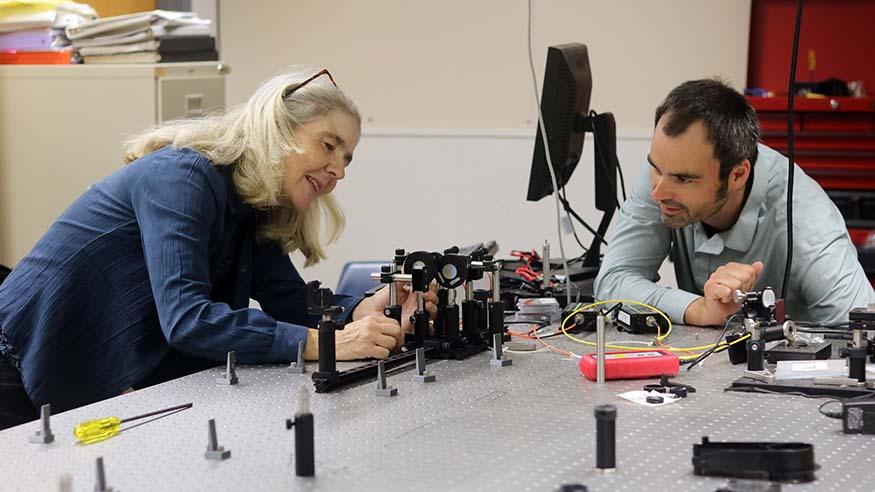
Dr. Cecilia Vogel, left, and Dr. Jim van Howe adjust the two polarizers that measure the polarization of the entangled photons.
Faculty move quantum science forward in research and classroom
Augustana physics faculty are finding ways to involve students in quantum research and discovery, while moving ahead with their own research.
Dr. Jim van Howe recently published research on a new way to help bring research-grade quantum technologies out of the lab and into commercial use.
And Dr. Cecilia Vogel recently built an entangled photon setup in Augustana's laser lab and has written corresponding teaching curriculum to be used for physics classes.
Measuring photon speeds
Dr. van Howe, associate professor of physics, and colleagues at the Institut National de la Recherche Scientifique in Montréal created a high speed “stopwatch” for measuring precise time delay between when a single photon passes a “starting line” and a “finish line.”
The ability to precisely measure these time delays is critical for many applications. For example, many satellites, drones and self-driving cars use lidar (light detection and ranging) to measure the time delay from when a laser pulse is sent from the vehicle and when it reflects back.
The time delay shows how far away an object is. The data also can reconstruct an image of the object, so a self-driving car would know if it was a tree, for example, or another car.
The time delay between when a molecule is excited by a laser pulse and fluoresces (glows) and when that light wanes can be used to identify a particular molecule. It also can reconstruct high-contrast microscopic images of tissue and is used in medicine to examine cells and tumors.
Dr. van Howe said he has been working in laser research at Augustana since 2007, but it wasn't until 2018 that he began delving into quantum optics and quantum applications.
The team used a unique fiber optic telecommunication technique to speed up an existing commercial single photon detection system by approximately 100 times. This approach allows a small, room-temperature commercial system to match the speed of large research lab systems that require cryogenic cooling.
Their research is at High-Resolution Time-Correlated Single-Photon Counting Using Electro-Optic Sampling.
Quantum experiments in the classroom
Dr. Vogel, professor of physics, built an entangled photon setup in Augustana's laser lab. Dr. van Howe and former students Hussam Ibrahim '17 and Liam Russell '21 assisted. Dr. Vogel completed the project and made it accessible to students for PHYS 213 Modern Physics and PHYS 401 Quantum Mechanics.
Entanglement means that two or more particles instantaneously exhibit the same characteristics when measured, no matter how far apart they are.
In the case of the apparatus at Augustana, two photons are created as both vertically polarized and horizontally polarized, until they are measured. If one is measured vertically, then the other is automatically vertical. Likewise, if one is measured as horizontal, the other is horizontal.
"Imagine if the two coins always landed both heads or both tails, never one of each," Dr. Vogel said. "That is the behavior of the entangled photons — random polarizations, but always the same as each other. The photons could be at opposite ends of the universe and still correspond."
Dr. Vogel’s demonstration begins with a lesson on classical polarization (as one might see in polarizing sunglasses), and then demonstrates the surprising difference in polarization behavior for quantum entangled photons. Augustana students and faculty got a sneak peak of the demonstration at last spring’s Celebration of Learning in the talk, "Quantum Entanglement for Introductory Physics Students."
The entangled photon setup will be a permanent part of the laser lab at Augustana, where students will continue doing research and Senior Inquiry projects.
